

Flip the classroom - every teacher should do this. Salman Khan was a hedge-fund manager but there’s not a teacher on the planet who wouldn’t benefit from his views on learning.

Khan has recorded 2200 educational videos and over million are viewed a month. How did he get started? By tutoring his cousins in maths. Eventually, they told hm that they preferred his YouTube lectures to him in person. From their point of view it makes sense – they can stop and review things when they want, do things at their own pace, do it when it's convenient. Flip the classroom Khan’s trick, is something I’ve believed in for years. Flip assessment He uses another flip technique I’ve always recommended. For Khan, overall summative assessment is all wrong.
To this end his whole system relies on detailed formative data for teachers, data that is both detailed and personal. The flip has one other major advantage. Conclusion. Flipping your Classroom - 13 Must Read Resources. Research. Technology-Rich Learning:Evidence on Flipped Classrooms Is Still Coming In. ascpro.ascweb.org/chair/paper/CEUE40002013.pdf. www.uco.edu/academic-affairs/cettl/cettl-files/newsletter-docs/2013-03/2013-03-tl.pdf. My flipped classroom journey!
Teacher Perceptions of the Flipped Classroom: Using Video Lectures Online to Replace Traditional In-class Lectures : UNT Digital Library. The Ultimate Guide To Flipping Your Classroom. Note: This is part 1.

“A reversed teaching model that delivers instruction at home through interactive, teacher-created videos and moves “homework” to the classroom. Moving lectures outside of the classroom allows teachers to spend more 1:1 time with each student. Students have the opportunity to ask questions and work through problems with the guidance of their teachers and the support of their peers – creating a collaborative learning environment.”(1) The Flipped Classroom is a learning model where students are exposed to new ideas at home–often through videos–and then work applications of that learning at school–an approach that reverses, or “flips” the old approach. Improved use of classroom time.
Arguments against the Flipped Model include technology access at home, the way it can encourage the dated sequential, lecture–>practice–>quiz pattern, and the extra work of producing the videos. Your smartphone, a flip camera, etc. This is always a challenge, but the video below can help. www.flippedlearning.org/cms/lib07/VA01923112/Centricity/Domain/41/LitReview_FlippedLearning.pdf. Students, Please Turn to YouTube for your Assignments. One of my frustrations as a senior level Math teacher at Okanagan Mission Secondary in Kelowna, B.C., had always been insufficient classroom time to work with students.

I typically spent 80 percent of class time lecturing. I was the one doing the math; my students were passive observers. I spent hours coming up with innovative lesson plans to make my lectures more student-centred, but in reality I was the sage on the stage. I then sent the students away to struggle with homework on their own. Students regularly told me that they hit a wall when it came to completing their homework. Now the struggle has been brought into the classroom, with peers and teacher able to offer assistance.
Instead of traditional lectures dominating classroom time, the lecture is compressed and delivered via websites like YouTube, which students can view at home or anywhere they choose. I found it quite easy to lecture about math for 45 minutes, four times a day. Flipped classroom and a changing perception. Some rights reserved by Genna G Thinking about perception - I am now approaching the end of my first flipped academic year.
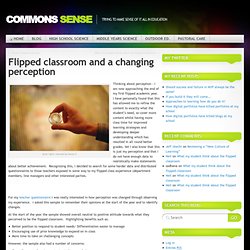
I have personally found that this has allowed me to refine the content to exactly what the student’s need, so cover more content whilst having more class time for improved learning strategies and developing deeper understanding which has resulted in all round better grades. Yet I also know that this is just my perception and that I do not have enough data to realistically make statements about better achievement. Recognizing this, I decided to search for some harder data and distributed questionnaires to those teachers exposed in some way to my flipped class experience (department members, line managers and other interested parties.
For my teacher questionnaire I was really interested in how perception was changed through observing my experience. However, the sample also had a number of concerns: However, new issues have also been highlighted: echo360.com/sites/all/themes/echo360/files/UT_Austin_2012.pdf. echo360.com/sites/default/files/Flipped%20Classroom%20Brief.pdf. Flipped Classroom Training & Technologies. Vodcasts and Active-Learning Exercises in a “Flipped Classroom” Model of a Renal Pharmacotherapy Module. Flipping the Classroom. Printable Version “Flipping the classroom” has become something of a buzzword in the last several years, driven in part by high profile publications in The New York Times (Fitzpatrick, 2012); The Chronicle of Higher Education (Berrett, 2012); and Science (Mazur, 2009); In essence, “flipping the classroom” means that students gain first exposure to new material outside of class, usually via reading or lecture videos, and then use class time to do the harder work of assimilating that knowledge, perhaps through problem-solving, discussion, or debates.
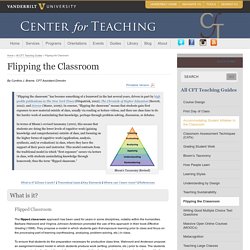
Bloom's Taxonomy (Revised)In terms of Bloom’s revised taxonomy (2001), this means that students are doing the lower levels of cognitive work (gaining knowledge and comprehension) outside of class, and focusing on the higher forms of cognitive work (application, analysis, synthesis, and/or evaluation) in class, where they have the support of their peers and instructor. What is it? | Does it work? Should You Flip Your Classroom? At its core, "flipped instruction" refers to moving aspects of teaching out of the classroom and into the homework space.
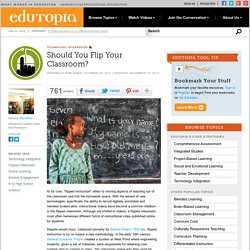
With the advent of new technologies, specifically the ability to record digitally annotated and narrated screencasts, instructional videos have become a common medium in the flipped classroom. Although not limited to videos, a flipped classroom most often harnesses different forms of instructional video published online for students. Despite recent buzz, catalyzed primarily by Salman Khan's TED talk, flipped instruction is by no means a new methodology. In the early 19th century, General Sylvanus Thayer created a system at West Point where engineering students, given a set of materials, were responsible for obtaining core content prior to coming to class. The classroom space was then used for critical thinking and group problem solving. The Pros. Five Best Practices for the Flipped Classroom.
Ok, I'll be honest.

I get very nervous when I hear education reformists and politicians tout how "incredible" the flipped-classroom model, or how it will "solve" many of the problems of education. It doesn't solve anything. It is a great first step in reframing the role of the teacher in the classroom. Flipped Classroom: The Full Picture for Higher Education.
The Flipped Classroom, as most know, has become quite the buzz in education.
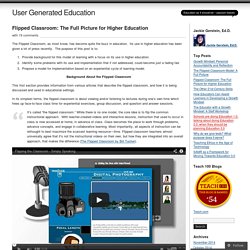
Its use in higher education has been given a lot of press recently. The purpose of this post is to: Provide background for this model of learning with a focus on its use in higher education.Identify some problems with its use and implementation that if not addressed, could become just a fading fad.Propose a model for implementation based on an experiential cycle of learning model. Background About the Flipped Classroom This first section provides information from various articles that describe the flipped classroom, and how it is being discussed and used in educational settings.
In its simplest terms, the flipped classroom is about viewing and/or listening to lectures during one’s own time which frees up face-to-face class time for experiential exercises, group discussion, and question and answer sessions. Flipped Classroom - Medical Education. Using the Flipped Classroom Group Time - Medical Education. Students can't sleep in my class because every 10 minutes their neighbour starts talking to them.
Students who aren't confronted with their misconceptions, leave the class thinking they know the content - Dr. Eric Mazur , Harvard Once you have determined which content needs to be taught individually vs in groups , it is time to decide on the teaching techniques you will use in the flipped classroom. As you are planning your activities, it is important to think about how you are going to scaffold the content students learned on their own to the higher order thinking they will do in the next phase of learning. This helps build the patterns so necessary for medical practice. Simple Options Jigsaw : As mentioned in the individualized techniques, students are divided into groups and each group investigates one area of knowledge which they report back to the classroom.
CTE - Flipping the Classroom. What is flipping the classroom?
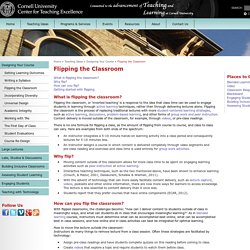
Why flip? tlt.its.psu.edu/files/2011/09/2011-Flipping-the-Classroom.pdf. tlt.its.psu.edu/files/2011/09/2011-Flipping-the-Classroom.pdf.